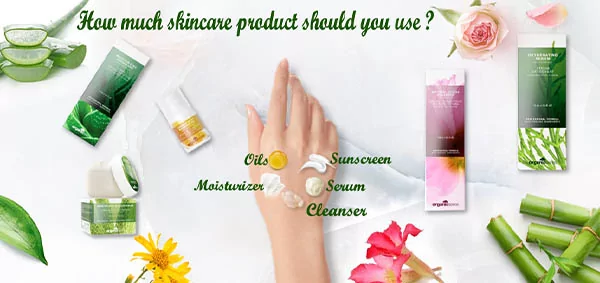By using your skincare products appropriately, you can get greater results. Top doctors give dosage suggestions with everything from cleansers and serums to moisturizers and more.
Here’s Why Sequence Is Important.
When you apply your skincare products in the correct order, your skin will get the full advantages of each product. You won’t get the optimum benefits from your skincare routine if you don’t use items in the right order.”
A step by step guide for to skin care regime.
So, you’re wondering which product goes on top of which. Apply your products from lightest to thickest consistency, or from liquid to cream, as a simple rule of thumb.
Your Morning Routine
Start your day by spraying warm water on your face or, if necessary, washing with a mild face cleanser suited for your skin type. A dime-sized quantity is all you need, whether you use a gel or a cream cleanser. One pump should suffice for a foamy cleanser. If you use makeup, a dermatologist recommends washing once in the morning and twice in the evening, or simply once at night if you don’t.
2. Toner
It’s fantastic for everyone since it helps to balance the skin’s pH levels and removes any remaining impurities before applying the remainder of your regimen. Most people avoid toners for a variety of reasons, one of which is a residual belief that toners are harsh and irritate the skin. Fortunately, that is no longer the case. While the latest generation of toners does not literally “shrink” pores, they can work as a delivery mechanism for antioxidants, vitamin B derivatives, and even toning acids. Furthermore, because each type of toner is designed to address a certain skin condition, it’s critical to use the correct one for your problem. However, if you’ve never used a toner before and your skin appears to be healthy, there’s no need to start now. Toners were designed to assist restore the pH of the skin after it had become excessively basic due to the use of harsh soaps. Toners are no longer necessary because face cleansers are so well balanced. However, if you have a favourite toner, there’s no wrong with continuing with it.
Apply toner on a hysteresis current rather than a cotton ball. Wipe your face and neck with the gauze pad.
Here’s Tip: If you have sensitive skin, avoid using toners because they might aggravate already sensitive skin. If you have acne, seek a toner that has lactic or salicylic acid, as well as calming herbs like aloe or chamomile. Look for AHAs, BHS, or glycolic acid to help with dark spots and ageing.
3. Oil-Control Serum – Organic Series
A pea-sized quantity of serum provides a concentrated boost of nutrients that aid in hydration, exfoliation, acne treatment, and dark spots. Because serums are highly concentrated, nutrient-dense treatments that target specific issues, it’s best to apply them as near to the skin as possible. There are several serums on the market today, but dermatologist suggests antioxidant serums for daytime use. Antioxidant serums provide a range of advantages, including reducing inflammation and neutralize damage caused by UV radiation and environmental toxins.
AGE-RELATED SKIN CONCERNS
Look for a serum that contains retinoids (retinal, retin-A, vitamin A) and peptides while trying to reverse or prevent ageing (stimulate collagen production).
ACNE
Acne is a difficult condition to deal with. You should use a serum and a treatment with Salicylic Acid, Benzoyl Peroxide, and/or sulphur, each individually. Examine what your skin responds to and what it does not. Niacinamide may be added to serum to assist with acne, ageing, and discolouration. As a result, a niacinamide serum and acne treatment for the full face is recommended.
DISCOLORATION
You’ve probably heard it before, but Vitamin C is the most effective substance for preventing and clearing acne.
SKIN THAT IS DRY AND DULL
Look for ceramides (which successfully retain moisture in or keep irritants out) and hyaluronic acid (which draws moisture into the skin to give it that shine) if you have dry, dull skin that needs some hydration and vitality.
4. Moisturizer
Your skin might feel tight and lack moisture if you don’t moisturize. DON’T FORGET TO COMPLETE THIS STEP! You’ll need one with SPF in the morning and one that’s moisturizing with rich, nourishing ingredients that won’t clog your pores at night.
Make a glob on each cheek, forehead, and chin with about a penny size quantity. Then after, massage it in until it’s all absorbed. You should apply a moisturizer even if your skin is greasy. After the damage that the sun, weather, and harsh chemicals cause to our skin, most of us require more hydration.
The optimum time to apply a moisturizer is when the skin is still wet, according to most experts, so the sooner you finish applying your serum and treatment, the sooner you can seal in much-needed moisture with your moisturizer.

5. Eye cream
It’s critical to use an eye cream at least once a night, if not twice a day. It’s all about maintaining healthy, thick eyelid skin. Improving the condition of the skin in this area early on guarantees that the eyelid skin retains its suppleness and smooth look.
Consistency is essential for the greatest outcomes. It’s important to remember that there is no such thing as magic. It takes time for results to appear. Choose an eye cream with SPF or use sunscreen every day to further protect the sensitive skin around your eye
Using too much eye cream can irritate your eyes, irritate your skin, and clog your pores. Applying too much makeup to your skin might make it difficult to apply your makeup.
If you apply too little: skimping on eye cream might dry the sensitive skin around the eyes, preventing makeup from effectively adhering to the skin.
6. Sunscreen
If you’re using a physical or mineral sunscreen that works by physically blocking UV rays, it should be the last step in your daily skincare routine. When applying chemical sunscreen, this process becomes more difficult. Everyone requires sunscreen daily. We all need protection from UVB and UVA radiation, whether we’re on the beach or at home working on the internet. Look for SPF 30, that’s all you need to protect yourself from 98 per cent of the sun’s rays. SPF protects against dark spots and ageing. You can use a mineral SPF that contains Zinc Oxide, often known as sunscreen, to block and reflect UVB and UVA radiation. It can leave a white cast, but it generally dissipates in about 20 minutes.
7. Oils
Pat your skin oil all over your skin moisturizer if your skin needs more hydration. This will provide a barrier to protect all of the skincare products you’ve just applied, allowing them to absorb fully.
delta
All Author Posts

